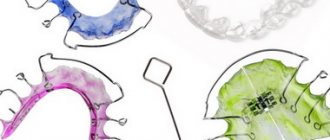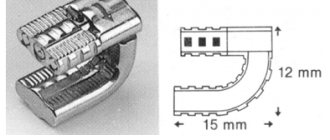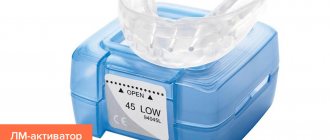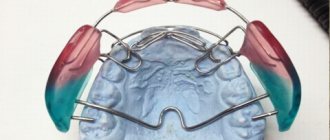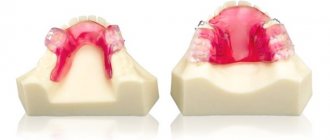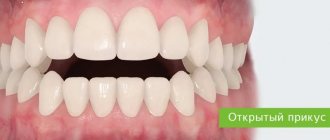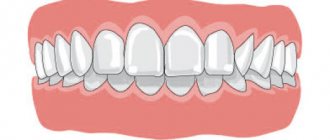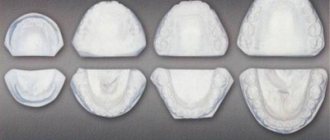The Frenkel appliance is one of the types of orthodontic appliances created to eliminate the problems of malocclusion, uneven teeth, and developmental deformities of the jaws in children.
This device allows parents from an early age to begin correcting congenital pathological disorders of the dentition (its use is allowed for children from 3-4 years old).
Features of the device design
The basis of the removable two-jaw apparatus is:
- complex metal frame;
- side (cheek) shields;
- lip pelota;
- loops for securing incisors and canines.
The frame is made of thin elastic wire, up to 1 mm in diameter, with three arcs:
- lingual;
- palatal;
- vestibular.
The arches are connected to plates made of plastic (less often metal); if necessary, screws and springs are additionally used to speed up the movement of certain teeth.
Double-jawed devices
Double-jaw orthodontic appliances are removable structures that correct the shape and width of the palate, the development and growth of the jaw bones, the position of the teeth in the oral cavity, and muscle tone. They are made in the laboratory using an individual impression, which is taken by an orthodontist. The devices have a base for the lower and upper jaws; retaining brackets, screws, hooks and springs are attached to the base.
As a rule, double-jaw appliances are used for treatment in childhood (when baby teeth are replaced by permanent ones), but sometimes they can also be prescribed to adult patients. Before eating or performing hygiene procedures, the structures can be easily removed, which is a big plus.
Photos of double-jaw orthodontic appliances
Twin Block
The Twin Block design includes two base plates, occlusal blocks with inclined planes, clasps, special arches, springs, control screws for proper fixation and impact on the jaw. The main functioning element here is an expansion screw fixed in the upper part of the device. The twin block is intended for the treatment and prevention of sagittal bite – an abnormal displacement of the jaw forward or backward.
Andresen-Goipl apparatus
The Andresen-Goipl apparatus consists of two basic elements fixed on the lower and upper jaws, which are connected to each other by a Coffin spring. On the top of the device there are two wings that fit tightly to the palate and lingual surface in the oral cavity. To ensure that the structure holds tightly, it has corresponding cavities that follow the shape of the palate and lingual surface. The Andresen-Goipl apparatus is designed to correct various types of violations, often with cross and mixed occlusions. During the treatment process, the orthodontist changes the position of the springs and screws, due to which the defects are corrected.
Frenkel apparatus
The Frenkel apparatus is a metal anatomical frame made of thin medical wire of increased strength, formed into special arches (for the palate, lingual cavity, vestibular and lingual arch). All arches are connected to the plates of the lower and upper jaws; special loops are attached to the arches, which secure the canines and incisors. In the case of treating very young patients, the device helps to get rid of bad habits associated with finger sucking, tongue swallowing, and also helps restore difficulty breathing.
Stages of installation of double-jaw orthodontic appliances
1
Examination, x-ray (if indicated), treatment (sanitation of the oral cavity)
2
Taking impressions, transfer to the laboratory
3
Manufacturing and installation of a two-jaw apparatus
4
Periodic visits to the doctor for correction (once a month)
Indications/Contraindications for installation of double jaw appliances
Indications
- Incorrect bite in children, adolescents, and sometimes in adults
- The need for expansion/constriction of the palate
- Incorrect and uneven position of teeth
- Preventive maintenance of teeth in the desired, correct position
- Gap between teeth
- Various types of violations, including cross and mixed occlusions
- Disturbances in the closure of the dentition
- Violations of dental aesthetics
Contraindications
- Inflammation of the gums in the form of gingivitis, periodontitis or periodontal disease
- Allergy to the material from which double-jaw appliances are made (metal, plastic)
Prices for double jaw appliances
| Name of service | price, rub. |
| Andresen-Heupl apparatus | 20000 |
| Frenkel apparatus (type 2.3) | 20000 |
| Twin block device | 22000 |
Operating principle of the Frenkel apparatus
Most orthodontic structures have a mechanical effect on the dentition.
Frenkel developed an absolutely unique technique based on a functional effect on the regulation of muscle tone, with its help you can achieve the following results:
- reducing pressure on the cheeks and lips on the jaw in problem areas;
- positive effect on the activation of functions and natural functioning of the muscular tissues of the oral cavity;
- normalization of nasal breathing;
- the device promotes the desired position of the tongue, closing of the lips and thereby ensures the harmonious development and growth of the jaws of young patients.
Operating principle
Unlike many other devices, correction of occlusion here is achieved by influencing the structural elements on individual muscles, processes of the alveolar ridges and areas of the dentition.
Due to this, the apical base, occlusal relationship, and movement of the tooth body are normalized.
The device allows you to eliminate excessive pressure on the lips and cheeks on problem areas, normalize the function of nasal breathing, proper closure of the lips, and form the desired position of the tongue .
Due to its wide capabilities, this device was called a function controller. The main importance in this design are shields and pads, which stimulate the expansion of the apical base in all directions and form the correct functioning of the muscles.
The main importance when using this device is the regulation of muscle tone. The design is made in such a way that it leads to relaxation of certain muscle groups in problem areas, as a result of which the correction is painless.
Elastic positioners have been developed for this device, which have a completely different appearance, but have the same functional effect as the Frenkel device.
Its difference lies in the possibility of combining elements to adapt to a specific problem, which significantly increases the effect of treatment .
Indications for use of the Frenkel apparatus
The effective period for the treatment of children's dental pathologies is considered to be the time of their active growth (4 - 12 years).
An orthodontic appliance is used for the following pathologies:
- distal bite (strong development of the upper jaw);
- mesial bite (pushing forward of the lower teeth);
- open bite (the lower and upper dentitions do not meet, a gap is formed);
- neutral bite (insufficient development of alveolar processes);
- narrowing of the dentition;
- twisted teeth.
Features of use
The Frenkel apparatus , or as it is also called, the Frenkel function regulator, has three varieties that are used in practice:
- Corrector, with the help of which the distal bite is corrected and the protrusion of the anterior teeth is eliminated;
- A corrector that corrects mesial bite of the jaw;
- A corrector that helps correct deep bites and, consequently, tooth retrusion.
In addition to the positive advantages, the Frenkel method has some disadvantages, which can make its use difficult:
- One of the disadvantages is the excessive complexity of the corrector, which takes a long time to produce;
- Long wearing period;
- And the last disadvantage is that the Frenkel apparatus, the price of which is quite high, may not be available to all patients.
Basically, it is for these reasons that the corrector is not very actively used in pediatric dentistry, but the indisputable fact is that with its use in the future the child will have a correct bite with a beautiful dentition.
In addition to the Frenkel apparatus, special dental mouthguards have recently been increasingly used to correct bites in children and adults. You can find out their specifications, as well as the price of dental mouth guards in our clinic, by clicking on this link:
Examination before physiotherapy
The appearance of the slightest signs of abnormal development of teeth in a child obliges parents to seek advice from an orthodontist.
After a visual examination, the doctor will suggest:
- take an x-ray or orthopantomogram of the upper and lower jaw;
- cure carious teeth and inflammatory processes in the oral cavity, if any.
Based on the images, the doctor will determine the type of pathology and prescribe treatment with the appropriate type of device design to eliminate the defect.
Bite correction Babushkinskaya, Medvedkovo
TOP 5 ways to correct malocclusion
Method number 1 - braces
Braces are very effective for correcting malocclusion at the age of formed bone structures.
Braces are used in the treatment of adolescent and adult patients. The design consists of small plates that are placed on the teeth in the form of separate elements; these elements are connected to each other by arches. The principle of tooth movement is mechanical. The orthodontist will control the movement of the teeth throughout the treatment, bringing them closer to the correct location.
Method No. 2 - aligners
In most cases, aligners will do an excellent job of correcting your bite. These are clear aligners that are made to move your teeth in the desired direction step by step.
Compared to braces, aligners are practically invisible on the teeth and are much easier to clean. But it is important to understand: the treatment plan is determined by the doctor based on the clinical situation. In some cases, an integrated approach to correcting the bite is used in several stages - braces and aligners.
Method No. 3 – orthodontic plates
An alternative way to correct malocclusion in adults without braces is to install an orthodontic plate. The orthodontic apparatus is attached to the teeth with special hooks, fitting tightly to the gums and palate. At first, this device creates discomfort in the functioning of the speech apparatus; it takes some getting used to. But most often, otodontic plates are used in the complex treatment of adult patients as a preparatory stage before treatment with braces.
Method No. 4 – trainers for correcting the bite
Trainers are quite massive structures made of silicone (when compared with aligners), effective for minor anomalies and defects of the dental system. Trainers are prescribed to adults to normalize breathing, swallowing, problems with diction and other features associated with malocclusion.
Trainers do not need to be worn all the time, usually for several hours during the day and at night.
Method No. 5 – surgical correction of the bite
This radical treatment method is used for genetic pathologies, serious injuries to the dental system, such as chin dysplasia and severe facial asymmetry. If treatment with braces is not possible, surgical correction of anomalies is resorted to.
For example, correcting an open bite through surgery is the most effective option to achieve alignment of a misaligned lower jaw during surgery.
Types of Frenkel apparatus
Different pathologies require different effects on the patient’s dental apparatus. There are four types of this design:
- FR - I is used to eliminate signs of distal occlusion with protrusion of the frontal teeth of the upper jaw, and with narrowing of the dentition. They consist of palatal and lingual arches, attached with upper and lower pelota. The cheek shields are connected to the lower pads using brackets. It is located in the oral cavity so that the shields do not come into contact with the alveolar ridge.
- FR-II is used to correct excessive inclination of the upper incisors (retrusion). It differs from the first type in the type of loop capes on the fangs and the presence of double pelotes. The shields are in close contact with the dentition and the crest of the alveoli. Made from transparent material.
- FR - III eliminates progeny (excessive development of the lower jaw). The design feature is the absence of lower pelotes and the presence of a vestibular arch.
- FR - IV corrects open bite, eliminates the reasons that hinder the development of the lower jaw. There are pads for the lower lip, a vestibular arch for the upper row, and metal pads. The device also helps to separate the bite.
Production
The device is created by specialists in a dental laboratory. It is removable and can be installed on two jaws at once. The design includes the following elements:
- frame;
- cheek shields;
- lip pelota.
The frame is made of durable metal wire, which is formed into arcs. There are several of the latter in the product:
- palatal;
- lingual;
- vestibular;
- lingual (added in some cases).
Pilots and shields are special flaps to limit unnecessary force. They can be either metal or plastic. The width is determined by the degree of pathology, but does not exceed two and a half millimeters. All elements are polished to avoid injury to the periodontium and dentin.
The product is manufactured individually for each patient. The basis is taken from impressions and impressions of teeth made in advance.
Rules and terms for using the Frenkel apparatus
In order for the treatment to be effective, the following rules and deadlines must be observed:
- The Frenkel apparatus is used at night and for a short time during the day (2-3 hours). During daytime treatment, it is forbidden to talk or eat food.
- It is imperative to carry out daily hygiene procedures for the oral cavity and orthodontic structure to avoid the development of caries.
- The duration of the treatment period is from 8 months to 1.5 years.
- Due to the intensive development of the child’s dental apparatus, the device changes 3-4 times during treatment.
Results after therapy with the Frenkel apparatus
The use of the Frenkel apparatus in eliminating deviations in the development of the dentition gives a good effect:
- eliminates the need for a surgical solution to the problem in later stages of the disease;
- Speech defects caused by dental pathologies are corrected.
- children get rid of bad habits (holding a finger, a pencil in the mouth).
- the effectiveness of treatment has a positive effect not only on the physical condition of the child, but also improves his appearance and psychological mood.
The Frenkel apparatus is actively used by orthodontists, is popular among patients and is considered a worthy alternative to the braces system.
Open bite treatment
Treatment methods for a disease such as open bite depend on the reasons that influenced its occurrence. The patient’s age and individual characteristics are also taken into account.
Treatment in adults
An orthodontist treats malocclusion in adults. Usually, at the first stage, the patient is selected the correct structures to straighten the dentition. These can be mouthguards, braces, plates, etc. In some cases, if the defect is too large, surgery may be prescribed.
Treatment in a child
A child's open bite usually responds better to treatment than an adult's. The doctor begins therapy by determining the causes of the pathology. If it is the influence of external factors, then such factors must be eliminated. It is also very important at this stage to carry out strengthening therapy, that is, start taking medications that contain calcium and other trace elements.
To return the bite to the correct shape, special designs are used. For young children, the use of mouth guards is sufficient. Older people are often prescribed to wear plates and braces.
